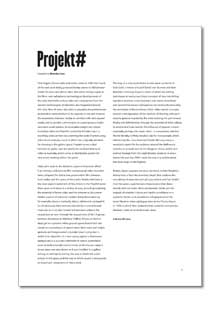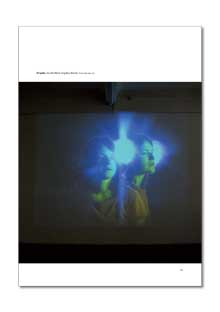 |
|||||||||
|
|
| ...Publications: Annual | ...The Physics Room Annual 2004 | ||||||||||||||
|
Projekt#. Dick Higgins, Fluxus artist and writer, wrote in 1966 that ‘much of the best work being produced today seems to fall between media’. No real coincidence, then, that while having origins in the filmic and radiophonic technological developments of the early twentieth century, video art’s emergence from the nascent technologies of television also happened around this time. Now 40 years old, video is, arguably, the predominant postmodern meta-medium in its capacity to mix and dissolve the boundaries between media, to combine with and expand media, and to provide commentary on contemporary media saturated social realities. An invaluable insight into recent Australian video art, Projekt#, curated by Brendan Lee, is a travelling video archive documenting the work of artists using video in art contexts, much of which was originally destined for showing in the gallery space. Projekt# serves a dual function; to gather and document the localised history of video in Australia, and to serve as distribution system for new artists working within the genre. Video art’s roots in the domestic space of television afford it an intimacy unknown to film, and personal video recorders have collapsed the distinction, preserved in film, between lived reality and the space of the media. Reality television is the most explicit statement of this. Artists in the Projekt# series draw upon such ideas in a variety of ways, including exploring the potential of home video and the internet to document hidden aspects of domestic realities. Kathy Bossinakis’ cry, for example, shows a markedly abject, adolescent-sociopathic list of (obviously fake) tortures enacted by a central female character on a cat, like Carolee Schneemann without the utopianism, as seen through the warped lens of the Chapman brothers. Elsewhere, in Matthew Griffin’s All eyes on Amin a dead girl on a pristine white ground spews blood from her mouth to a soundtrack of speed metal. More stark and simple gestures are foregrounded in Lyndal Jones’ crying man 1, which in its depiction of a man crying against a bluescreen background is a succinct statement of video’s potential to zoom in both neutrally and incisively on the human subject. Jones’ piece was also shown as it was installed in a gallery setting, an attempt to portray the way in which the audio echoes in the space, and the way in which sound is, necessarily, an important component of video work. The loop as a structural device is seen most succinctly in Emil Goh’s 1 minute at 9, and Daniel von Sturmer and Meri Bazevski’s Driveway Sequence, both of which use editing techniques to restructure linear concepts of time into lulling repetitive mantras. Leslie Eastman’s two works, Eraserhead and Several Provisional Contingencies not necessarily precluding the eventuality of Reconciliatory Union utilise similar concepts toward a reinvigoration of the medium of drawing, with each sketchy gesture enacted by the artist resisting the pull toward finality and definitiveness through the potential of video editing to rewind and erase events. The influence of popular culture - especially, perhaps, the music video - is everywhere, whether this be literally, in Philip Brophy’s clip for Honeysmack, which, referencing the cross-dressing Freddie Mercury, traces a musician’s search for his audience around the Melbourne suburbs, or in work such as the Kingpins’ Versus, which uses archival footage from the Leigh Bowery estate to re-enact Aerosmith and Run DMC’s walk this way, in a collaboration that time-leaps to the Eighties. Britney Spears appears not once but twice, in Kate Murphy’s Britney Love, a faux-documentary biopic that explores the sexualising of prepubescent girl pop culture, and Sue Dodd’s Fears for Spears, a performance-based piece that draws heavily both on music video and karaoke. Dodd sets her analysis of celebrity culture and media surveillance to a squelchy electro acid soundtrack, bringing to mind the Grunt Machine video catalogue, seen at the Physics Room in 1999, in which New Zealand artists explored connections between video art and the music video. Sally Ann McIntyre View Projekt#. Essay by Sally Ann McIntyre as a PDF This essay originally appeared in The Physics Room Annual 2004 Order your copy today from The Physics Room ! Related 2 - 27 March, 2004 PROJEKT#
|
||||||||||||||


